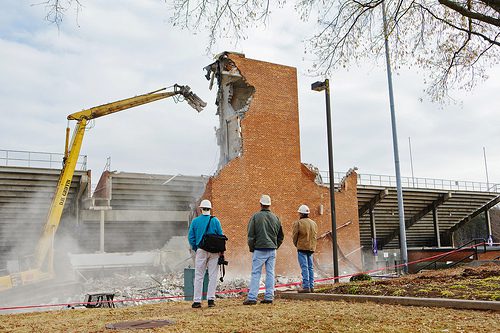New football complex energizes program

by Abe Hardesty, Furmanpaladins.com
As Paladin Stadium arose in the southeast corner of the Furman campus in the spring of 1980, third-year coach Dick Sheridan also observed changes on an individual scale.
“When you make a major addition to a program, it adds a lot of confidence to a coaching staff,” Sheridan says.
“To a coach, it’s an indicator that he came to the right place, and that the time and effort he’s spending is backed by efforts throughout the campus to improve the program. That’s exciting,” says Sheridan, whose teams won 28 of 33 games over the next five seasons.
Furman eventually won Southern Conference championships in seven of the first 10 years it played its home games at Paladin Stadium, a 16,000-seat facility that was a major improvement over the previous football home of 45 years – Sirrine Stadium, in downtown Greenville.
Bobby Johnson, an assistant coach when the stadium was built and head coach when the team reached the I-AA championship game 20 years later, says a major addition also helps coaches when they step away from the campus.
“It gives you a big boost. It’s a confidence boost any time an administration is behind you, and willing to put money into the program,” said Johnson, the defensive coordinator when Paladin Stadium was built. “It gives your coaches more confidence when recruiting. It gives them the ability to look those families (of prospects) in the eye and say, ‘you’re going to see a new facility under construction when you visit.'”
The first major improvement to Paladin Stadium began earlier this month when the stadium tower, which included the press box and athletic hall of fame room, was razed.
At approximately 44,000 square feet – seven times larger than the present facility – the new complex will provide a dramatic change in appearance. It will also provide more luxury club seating, significantly more meeting space for the football program, and a heritage hall showcasing Furman football history.
It promises to be picturesque and functional, and thanks to fund-raising efforts of the past year, its $12 million price tag is within reach.
Second-year head coach Bruce Fowler loves the project for more practical reasons. The proposed facility will double the number of meeting rooms and provide – for the first time in the 100-year history of the football program – a meeting room large enough to accommodate the entire team.
It will also provide state-of-the-art technology for the staff, and upgraded training facilities.
Presently, no room can accommodate more than 35. For team meetings, the players and staff meet at Timmons Arena.
“The additional meeting room will make us more functional,” Fowler says. “In addition to more meeting rooms, the audio-visual technology will enable us to communicate better. It will be more like a classroom setting; it will have better communication tools.”
The stadium addition, Fowler says, should enhance Furman’s ability to recruit students – football and non-football alike.
“Students in general, when they visit schools, naturally compare one place to another. Facilities are not the only thing they look at, but it’s a big part of it,” Fowler says. “This will make our school more appealing to any student.
“This building puts another piece in place, another part of an overall quality program,” says Fowler, a senior member of the football team when Paladin Stadium was under construction. “It reflects a striving for excellence in all areas.”
Ken Pettus, another assistant coach when Paladin Stadium was built and now associate athletic director for development, hopes the first major improvement to the football stadium will energize fans in the same way it encourages coaches and players.
Pettus, a former college linebacker and point man on the funding aspect, says Furman has reached out to all former players, and contributions from alums have already topped $2 million. More than $10 million of funds have been pledged for the complex, most of it from large donors.
For the last $2 million, Pettus and his committee will take their case primarily to those who might be able to help in smaller way, in a critical phase of the project which he likens to “an Amish barn-raising.
“We need the involvement of every member of the Furman community,” Pettus says, hoping to attract as many gifts as possible.
The fund-raising received a boost from rapid sale of the 156 club seats that will dominate the third level.
The lower two levels of the complex will be devoted to the football program. The plans include rooms that will accommodate all eight position groups (only four rooms are available now, forcing some groups to meet in locker rooms), and an office for each coach. The training room will be expanded and modernized. The entrance connecting Paladin Plaza will also feature a heritage hall, which will serve as a display area for the school’s multiple championship football trophies, awards, and other memorabilia.
The complex’s top level will serve as home to working press and feature a spacious television broadcast booth, home and visiting radio booths, coaches boxes, and twin photo decks, as well as public address and ultra-modern video production room.
“It’s going to be a massive, huge building,” says Pettus, “and it’s going to be a beautiful building.”
It is also an essential one in terms of Furman’s efforts to be competitive in Division I and the Southern Conference. In recent years, every other conference member has upgraded its athletic facilities.
The facility is scheduled for completion in late 2013.
Design is by McMillian, Pazdan, Smith Architecture of Greenville, and the builder is Triangle Construction, which recently completed Furman’s new Herring Center for Continuing Education and several other athletic facilities in the Upstate, including the press box and field house at Presbyterian College, the Davis Field House at Bob Jones University, and the Carolina Panthers Training camp on the Wofford College campus.